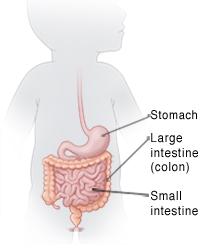When Your Child Has Intestinal Malrotation
When Your Child Has Intestinal Malrotation
While a baby is still in the womb, its bowels (intestines) form. As they form, they move into their normal position in the belly (abdomen). Intestinal malrotation happens when the intestines don’t form in the right position. The intestines may bend the wrong way. Or, parts of the intestine may end up in the wrong part of the abdomen. Bands of tissue called Ladd bands can grow between the intestines and body wall. These secure the intestines in the wrong place. Ladd bands can also block part of the intestine and cause digestive problems.
Why is intestinal malrotation a problem?
Intestinal malrotation most often isn’t a problem by itself. But it makes a child more likely to have a twisted intestine. This is called a volvulus. A volvulus can be very dangerous. This is why intestinal malrotation needs to be treated, even if your child has no symptoms.
What are the symptoms of intestinal malrotation?
In many cases, the condition causes no symptoms. If symptoms do occur, they often happen during a child’s first year and signal intestinal blockage. These symptoms can include:
Vomiting that may contain green bile
Mildly bloated abdomen
In severe cases, vomiting of blood and blood from the rectum
Fever
Belly (abdominal) pain
How is intestinal malrotation diagnosed?
In some cases, the problem may be found during a test for another health problem. In other cases, the healthcare provider will ask about your child’s symptoms and health history. He or she will give your child a physical exam. Your child may have tests such as:
Abdominal ultrasound. Sound waves are used to create an image of the inside of the abdomen.
Upper GI series. X-rays are taken of the upper digestive tract from the mouth to the small intestine. Your child swallows a chalky fluid with barium. This liquid coats the insides of the upper digestive tract. The barium causes it to show up on an X-ray.
Barium enema. Barium is inserted through the anus into the rectum. It coats the inside of the lower digestive organs so they show up on an X-ray.
How is intestinal malrotation treated?
For intestinal malrotation, surgery will be scheduled. During surgery, Ladd bands are cut. The intestines are then moved to where they will be least likely to twist. If the child still has his or her appendix, it will be removed during the surgery.
For intestinal malrotation with a volvulus, surgery is done right away. The intestine is carefully untwisted. If a part of intestine has died due to lack of blood flow, this part must be removed. The healthy ends of the intestine are then reattached. If a long length of intestine is removed, a small opening (stoma) may need to be made in the child’s abdomen. This provides a new way for waste to leave the body. If your child needs a stoma, the healthcare provider will tell you more.
When to call the healthcare provider
Call your child’s healthcare provider right away if your child has signs of volvulus, such as:
Stomach pain and swelling
Vomiting
Inability to pass stool
Updated:
March 21, 2017
Sources:
Intestinal Malrotation. UpToDate.
Reviewed By:
Freeborn, Donna, PhD, CNM, FNP,Lehrer, Jenifer, MD
